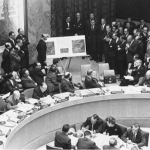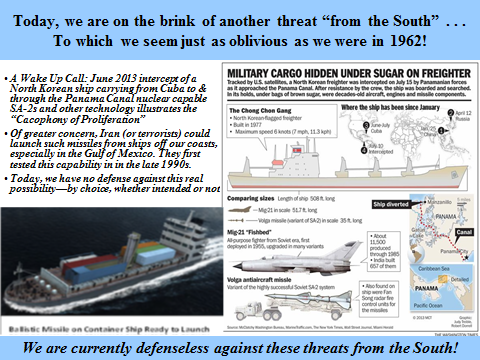“ . . . As the photographic evidence makes clear, the installation of these missiles, the erection of these missile sites, has taken place with extraordinary speed. One entire complex was put up in 24 hours. This speed need not only — not only demonstrates the methodical organization and the careful planning involved, but it also demonstrates a premeditated attempt to confront this hemisphere with a fait accompli . . .” Ambassador Adlai Stevenson, before the United Nations Security Council, October 25, 1962
On October 22, 1962, as a young Bell Telephone Laboratories engineer on the heels of celebrating with our development team the deployment of Telstar, the first telecommunications satellite — and also a grad student at New York University, I vividly remember watching a Student-Union black-and-white TV broadcast of President John F. Kennedy’s address to the nation. The President announced that the Soviet Union was deploying nuclear weapons in Cuba, only 90 miles from our Florida coast — and the actions that the United States was taking in response. (For that unedited broadcast, click here.) And after class, I hurried home in New Jersey to prepare with my wife and daughters for a time in the basement should the need arise.
While we continued with our planned daily lives, we regularly watched the news — and it was news in those days. Then 54 years ago today, U.S. Ambassador Adlai Stevenson challenged the Soviet Union in the United Nations Security Council and met their denials by making public U-2 photographs proving to all the existence of the missiles in Cuba. Click here for the transcript, and a brief video of a portion, of that historic presentation.
Two days later, Rudolf Anderson, Jr., from Greenville, SC and commissioned from the Clemson Cadet Corps class of 1948, became the only U.S. casualty during the Cuban missile crisis, resulting from enemy fire on October 27, when a Russian SA-2 interceptor shot down his U-2 high altitude surveillance aircraft while providing more intelligence. By order of President John F. Kennedy, Major Anderson was posthumously awarded the first Air Force Cross, as well as the Distinguished Service Medal, the Purple Heart, and the Cheney Award.
For the rest of the Cuban Missile Crisis’ fateful 13 days (which were already at midstream), we and all Americans reviewed our “duck and cover” preparations for what seemed to be a looming holocaust. Kennedy declared the highest nuclear alert short of launch, DEFCON II, which, among other things, may have involved plans to deploy NATO aircraft (among others) to bomb Soviet targets. We now know from Soviet records of those fateful events, publicly released in the early 1990s, that we were even closer to that brink than we then realized.
Soviet leader Nikita Khrushchev’s promise to President Kennedy on October 28 that he would cease deploying nuclear-armed missiles in Cuba ended the crisis and the blockade. But unknown for decades was that 100 smaller Soviet nuclear warheads were already in Cuba, and Fidel Castro wanted to keep them. Had he prevailed, Cuba could have become a nuclear power. And if Kennedy had known that Khrushchev had all but lied on October 28, the U.S. might have undertaken an all-out invasion of the island, triggering a holocaust. Happily, these weapons were also removed by the end of 1962.
Among the lessons of these events, which many consider the closest we came to a nuclear exchange during the Cold War, is that our intelligence community can be badly informed.
Our technical capabilities for gathering information are much improved since a half-century ago, but this lesson remains true — even regarding the possibility of a renewed threat to the United States of a nuclear attack from the south, courtesy not just from the Russians but from North Korea or Iran — or even terrorists if they gain access to nuclear weapons. And in June 2013, we may have seen a dry run for such a threatening event — see the chart below. Note the SA-2 interceptors, which are in fact capable of carrying nuclear weapons, are exactly the same as those that shot down Major Anderson’s U-2 during the Cuban Missile Crisis over a half century ago.
As also noted on the left of the above chart, these nuclear weapons could be mounted on SCUD missiles purchased for a few million dollars and launched from vessels off our coasts to attack nearby cities — using missile launchers that can be purchased, e.g., from Russia. Or they could be detonated above the atmosphere to create a massive electromagnetic pulse (EMP), and the consequent loss of electricity would stifle out “just-in-time” economy and possibly lead to major loss of life due to starvation, disease and societal collapse.
As recently discussed in my October 3 “First Truths” message (click here), the authoritative EMP Commission reported eight years ago in an open congressional hearing that up to 90-percent of all Americans could perish if we do not protect against this all too real possibility — and regrettably nothing has changed since then. So this is an existential threat.
While our missile-defense site in Alaska provides a limited defense against long-range intercontinental ballistic missiles (ICBMs) launched from North Korea or Iran and approaching the United States from over the North Pole, it is ineffective against this “threat from the sea,” especially from the Gulf of Mexico. Moreover, North Korea and Iran have both launched satellites to their south. They could carry nuclear weapons to attack the United States from our undefended South. (Click here for a year-old discussion of that important threat with recommended near-term countermeasures — and nothing has changed to improve the current situation.)
We should end our vulnerability to attacks from the Gulf of Mexico by deploying the Navy’s Standard Missile 3 (SM-3) interceptor and an associated radar and command-and-control system at several military bases around the Gulf of Mexico. This deployment would be a homeland-defense version of the Aegis Ashore BMD system we are deploying in Romania (now operational) and Poland (to be operational in 2018). (Aegis Ashore is essentially a land-based version of the BMD system currently based on about 35 Aegis ships around the world.)
The Pentagon’s Missile Defense Agency is deploying the needed Aegis Ashore infrastructure in Romania (now operational) and Poland (to be operational in 2018). This capability can be deployed quickly on Gulf of Mexico coastal military sites. Given the anticipated defense footprint of the SM-3 interceptor to be deployed in Poland, only three or four sites would be needed. See below for some potential sites.
I urge that the initial Aegis Ashore site be on Tyndall AFB in Panama City, Florida — home of First Air Force (Click here.) which already has the mission of defending the Continental United States against air attack. Adding the defense against sea-launched ballistic missiles from the South would be a natural extension of its role as a direct report to the NORAD/Northern Command Commander in Colorado Springs, who is the designated commander of our defenses against air and missile attack on all of North America.
Note: The R&D has been done for the system which is being deployed to help protect our NATO allies — no more is needed to deploy the same system on military bases around the Gulf of Mexico. If the American people can afford to protect our NATO allies — and I believe we can and should, we can surely afford to defend Americans at home.
This is an urgent matter.
Whatever were the uncertainties in 1962, President Kennedy knew he was dealing with an adversary that could be deterred from carrying out an existential threat to America. Today we confront an Iranian regime that seems dedicated to destroying the “Great Satan,” America — and may even seek an “end times” catastrophe to hasten the “return of the Mahdi.”
It is not at all clear that the Iranian Mullahs can be deterred. Indeed, many of their actions — and words — suggest that they are quite prepared to commit suicide to kill a multitude of Americans and destroy all we hold dear. And surrogate jihadi terrorists are certainly inclined to execute such “suicide” missions.
We must respond with defenses needed to protect all Americans from such possibilities.
A quick fix to our current vulnerability to this near-term threat is necessary, but not sufficient. Also needed is a comprehensive, increasingly robust missile-defense system to defend all Americans and our overseas troops, friends, and allies from the likely greater numbers of more capable future ballistic missiles.
What can you do?
Join us in praying for our nation, and for a rebirth of the freedom sought, achieved and passed to us by those who came before us.
Help us to spread our message to the grass roots and to encourage all “powers that be” to provide for the common defense as they are sworn to do.
Begin by passing this message to your friends and suggest they visit our webpage www.highfrontier.org for more information. Also, please encourage your sphere of influence to sign up for our weekly e-newsletter.
Encourage them to review our past email messages, posted on www.highfrontier.org, to learn about many details related to the existential manmade and natural EMP threats and how we can protect America against them.
Click here to make a tax deductible gift. If you prefer to mail a check, Please send it to 500 North Washington Street, Alexandria, VA 22314.
E-Mail Message 161025
Please click here to read Past Weekly Updates!
Please help High Frontier continue this important and timely work!
Be sure to follow us on our Social Sites!
If you found this letter via our Social Sites, and you would like to subscribe, please click below!







